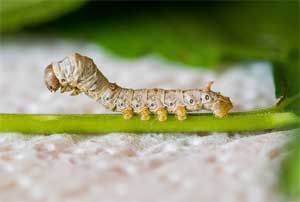We are continuing our Fabric Sources series of articles with education on fabrics made from living things. While we are all familiar with leather being used in fashion and home décor, for the purpose of this article, we will only be exploring the sources that create woven or knitted fabrics. In this 3-part section, we’ll start with discussing silk and continue our next 2 articles with wool and “other.”
Plants (part 1) | Plants (part 2)
Living Things: Silk | Living Things: Wool | Other Living Things
Minerals: Acrylics, Polyester, & Nylon (part 1) | Minerals: Spandex and Rayon (part 2)
Silk
Did you know that silk is made from two different sources? The most common silk comes from the silkworm. But there is also a far less common silk made from strands made by spiders. Both produce a natural protein fiber which can be woven into textiles. Let’s talk about the differences.
Silkworms
 The best-known type of silk is obtained from the cocoons of the silk moth. This moth is a completely domesticated moth and does not exist in the wild. The practice of breeding silkworms to produce raw silk (a.k.a. sericulture) began over 5,000 years ago in China but soon spread beyond to India, Korea, Nepal, Japan, and the West.
The best-known type of silk is obtained from the cocoons of the silk moth. This moth is a completely domesticated moth and does not exist in the wild. The practice of breeding silkworms to produce raw silk (a.k.a. sericulture) began over 5,000 years ago in China but soon spread beyond to India, Korea, Nepal, Japan, and the West.
How is it processed
Silkworm cocoons are placed in hot water to soften the gum which, sadly, kills the insect inside. The cocoons are softly brushed to find the end of the filaments. The cocoon is unwound carefully to maintain the integrity of the fibers, which can be very long. The ends of the filaments are then reeled on to a wheel and twisted (spun) into the desired strength and thickness. Finally, the spun thread is boiled in soap and water (called degumming) to prepare it for finishing and dying. To get a glimpse of the process, watch this 2-minute video:
Pros
Silk is a luxurious fiber that can be woven in a wide variety of textures, smooth like China and Thai silk or nubby like silk shantung and silk tussah. It is a strong fiber that creates a comfortable fabric.
Cons
Silk can get quite expensive and stains easily. It usually requires dry cleaning since laundering silk typically changes the texture and sheen of the fabric. But if that is the look and feel you are going for, launder away. You be the judge!
Impact on the silkworms
Approximately 3,000 silkworms die to make every pound of silk. Animal activist groups believe that silkworms experience fear and have a physical response to pain in the processing.
Where can I buy it?
Silk made from silkworm cocoons is a fabric you will not have any trouble finding. Since it can get expensive, you can save a few pennies by buying it with your ASG Member discount from one of these sellers:
Spider
Spider silk has been sought by the U.S. military for applications like body armor, parachutes, and rope due to its strength and light weight. And, though with great difficulty, has been the subject of an incredible exhibition at the V&A museum as displayed in an amazing golden silk cape woven entirely from silk harvested directly from spiders. Take a peek at the cape in this 2-minute video.
How is it processed
Silk is pulled by tweezer from the spinnerets of the spider and attached to the spool with a dab of glue after which the motor is started to begin harvesting. It’s possible to harvest between 30-80 yards of silk in one go. Watch this interesting video of the process. Because of the extremely labor-intensive nature of harvesting true spider silk, research into simulating the strong spider silk artificially has been pursued and offers promising results.
Pros
Spider silk is one of the strongest and elastic natural fibers known. It is five times stronger than steel and three times tougher than Kevlar. And the silk of the ogre-faced spider can be stretched six times its original length without damage.
Cons
Spider silk is difficult to harvest and thus expensive and difficult to source.
Impact on the spiders
To harvest true, natural spider silk, the spider must be sedated and constrained, after which the spider can be released back to its web to feed ready for reeling another day. While the spider is said to remain unharmed during this process, it certainly isn’t in line with its natural habitat.
Where can I buy it?
While the superior properties of spider silks are well known, there is no known way to produce natural spider silk in commercial quantities. Besides the labor-intensive process of harvesting natural silk from spiders, spiders are also cannibalistic. So even if the harvesting challenge were overcome, they cannot be raised in concentrated colonies to produce silk. I was not able to find ready sources of synthetic spider silk either. So, the short answer is – you won’t be buying this silk for your home sewing stash. Better go see the cape at the V&A museum!
~Sheryl Belson





